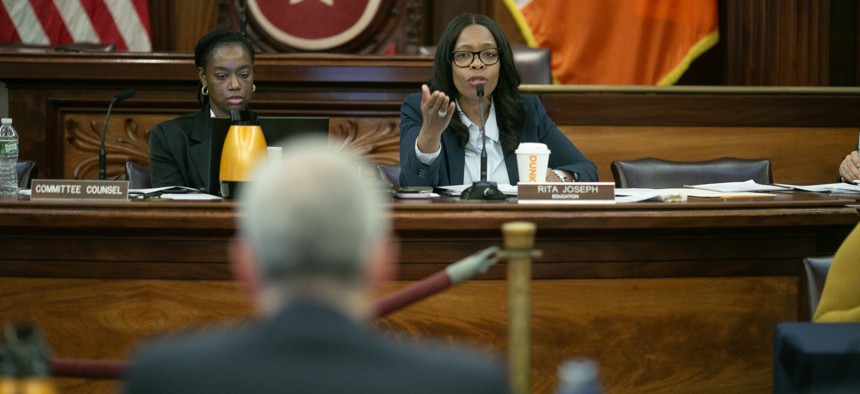It was all hands on deck at City Hall on Thursday as elected officials and education advocates slammed the New York City Department of Education at a hearing for what they described as not taking adequate steps to ensure schools comply with a law to reduce class sizes over the next five years.
While top education officials expressed concerns about the “tough choices” ahead, the city assembled a broad coalition of advocates, educators, parents, and researchers into a working group last year that released dozens of recommendations on how the city should comply with the law. City Council members, advocates as well as state Sens. Robert Jackson and John Liu expressed frustrations that the city has yet to act on that guidance and pushed back on education officials’ claims about the law being an unfunded mandate.
Some of the key recommendations in the report included capping student enrollment at overcrowded schools, rolling out financial incentives aimed at boosting teacher hiring and retention, and moving preschool programs out of school buildings into local organizations.
“So here’s my issue. The people that are making the decisions have never taught in New York City schools,” City Council Education Committee Chair Rita Joseph said, addressing education officials at the hearing. “Class size does matter – it matters to me and it matters to all of my educators across the city. In order for us to get it right, we also need people at the table, and that’s why we have the working group. That’s why I’m a little bothered that some of the recommendations were not applied.”
Department of Education First Deputy Chancellor Dan Weisberg said officials shared the City Council’s goal to lower class sizes and that they were committed to complying with the law, but warned there were trade-offs associated with many of the working group’s guidelines. For example, hiring more teachers would require money that would need to be pulled from somewhere. The same goes for repurposing space at a school – using it for a classroom would likely mean taking it away from other uses. Limiting school enrollment at overcrowded schools – many of which would likely be high-performing schools – would likely upset parents, he added.
“What we are doing is just making sure that there are no unintended consequences as we drive towards this goal and that we are very honest and transparent,” Weisberg said. “What we don’t want to have happen is we implement this law, which becomes much more difficult in year three, four and five, and it has all kinds of ramifications.”
One way the department has complied with the working group’s recommendations is by conducting a survey of New York City principals to better understand each school’s space and staff needs.
There has been a great deal of debate since state lawmakers passed legislation in 2022 requiring the New York City public school system to gradually phase in requirements for lower class sizes starting in September 2023. While the news was heralded by teachers and advocates who’ve long pointed to research that indicates smaller class sizes improve student learning outcomes, city officials have continued to voice concerns about associated costs.
Caps would vary depending on the grade – including no more than 20 students in a class for K-3, no more than 23 for grades four through eight, and no more than 25 high schoolers. One year into the law’s implementation, that’s not a problem. Nor is it expected to be a big challenge next school year, according to Emma Vadehra, the education department’s chief operating officer, who said that around 40% of classrooms are currently in compliance with the law. Challenges would lie ahead in the latter years.
Education officials contend that the biggest hurdle is the cost. An estimated roughly 500 schools would need more classrooms than they currently have, and according to Vadehra, the city will need to hire an additional 10,000-12,000 new teachers at an annual cost of $1.4 billion to $1.9 billion. Without that additional funding from the state, education officials claim the city will need to make tough decisions to comply, including potentially cutting existing programs.
While state lawmakers have said the state has sent the city $1.6 billion in Foundation Aid that should allow the city to comply with the law, education officials said Thursday that the money is already in New York City school budgets.
“The idea that this was an unfunded mandate, there’s no basis in reality whatsoever,” said Liu, sponsor of the class size measure and chair of the state Senate’s New York City Education Committee.


